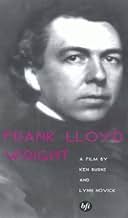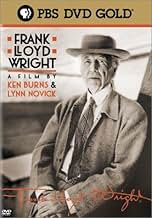Ajouter une intrigue dans votre langueA biography of the life and work of the American architect.A biography of the life and work of the American architect.A biography of the life and work of the American architect.
- Réalisation
- Scénario
- Casting principal
- Nommé pour 1 Primetime Emmy
- 3 victoires et 2 nominations au total
Edward Herrmann
- Narrator
- (voix)
Avis à la une
10OGRE-8
After watching this film I cried knowing that prefection was attainable. For proof all you need do is look at the many buildings that are a testament to Frank Lloyd Wright's immortality.
This is an absorbing and informative documentary on an architect who in most expert opinion - and certainly in his own! - was one of the greatest architects ever. His buildings are of particular interest to film buffs, because they have been used as the locations in many movies. For example, the Ennis-Brown House in LA was the House on Haunted Hill and was also in Blade Runner. But, in fact, where this documentary scores is in focusing on Wright's amazing life, as much as on his architecture. Born in 1867, Wright had early success in building houses around Chicago, but after a scandalous and tragic personal life he was more or less finished professionally by the 1920s.
But then, with the encouragement of his wife Olga Lazowich, his career revived and took off when he was over 60. In the 30 years before his death in 1959 he and his associates designed hundreds of buildings, the best known being the Guggenheim Museum in New York. The Guggenheim is probably his most striking external design, and resembles an abstract sculpture, though ironically Wright had a poor opinion of the 20th century non-objective paintings it houses. The film is admirably linear, with none of the gimmicks found in many modern TV documentaries; it has beautifully angled shots of Wright's best structures; and is enhanced by Beethoven music, since Wright thought musical composition had affinities with architecture.
But then, with the encouragement of his wife Olga Lazowich, his career revived and took off when he was over 60. In the 30 years before his death in 1959 he and his associates designed hundreds of buildings, the best known being the Guggenheim Museum in New York. The Guggenheim is probably his most striking external design, and resembles an abstract sculpture, though ironically Wright had a poor opinion of the 20th century non-objective paintings it houses. The film is admirably linear, with none of the gimmicks found in many modern TV documentaries; it has beautifully angled shots of Wright's best structures; and is enhanced by Beethoven music, since Wright thought musical composition had affinities with architecture.
Like many great men, Frank Lloyd Wright was complex and controversial. You either love his architecture, or you hate it. Few people are lukewarm about Wright's work. After seeing this documentary, few will be lukewarm about the man.
Raised on the idea that he was destined for greatness, Wright behaved throughout his life as if he were above the constraints of ordinary people. This documentary takes an unflinching look at the turmoil this caused in Wright's life.
The vignettes of family members are moving, particularly a scene near the end when his grandson recalls Wright's death. By simple chronological narrative, Burns takes us from dazzling heights when Wright's fellowship was thriving artistically and financially, to dismal lows when his wife had to wear hand-me-down coats in the cold Wisconsin winter.
The commentaries by architecture illuminati are illuminating, if perhaps a bit insular. Vincent Scully gained fame at the distinguished Yale School of Architeture. Phillip Johnson, a graduate of Harvard, once referred to Scully as the most influential teacher of architecture in history, and used his position as founder of MoMA Department of Architecture and Design as a bully pulpit to vilify Wright's work during Johnson's association with Bauhuas buddies Meis and Gropius. Robert A. M. Stern is currently Dean of Yale's School of Architecture, and with Scully, was responsible for popularizing the work of great architects like Robert Venturi. Still, this cabal of academic elitists sing a harmonious chorus of praise to Wright that demonstrates the rising and falling tides of Wright's popularity.
The documentary will not satisfy those who merely wish to see a catalog of Wright works, and after all, is there anyone alive who hasn't explored that body of work? It focuses instead on Wright the man, something much less understood. Wright is described as everything from a genius, a charlatan, and a con artist, to the greatest American Architect, and probably all are true. But if Wright and his early mentor Louis Sullivan were correct that form follows function, then perhaps genius is best understood by examining the life that developed it.
The makers of this film "get" Wright, and the consistency of Wright's vision, from his earliest work, to mid-career masterpieces like Fallingwater, to his final triumph with the Solomon R. Guggenheim Museum on Fifth Avenue in New York City is presented with insight and perspective. A great documentary about a great man.
Raised on the idea that he was destined for greatness, Wright behaved throughout his life as if he were above the constraints of ordinary people. This documentary takes an unflinching look at the turmoil this caused in Wright's life.
The vignettes of family members are moving, particularly a scene near the end when his grandson recalls Wright's death. By simple chronological narrative, Burns takes us from dazzling heights when Wright's fellowship was thriving artistically and financially, to dismal lows when his wife had to wear hand-me-down coats in the cold Wisconsin winter.
The commentaries by architecture illuminati are illuminating, if perhaps a bit insular. Vincent Scully gained fame at the distinguished Yale School of Architeture. Phillip Johnson, a graduate of Harvard, once referred to Scully as the most influential teacher of architecture in history, and used his position as founder of MoMA Department of Architecture and Design as a bully pulpit to vilify Wright's work during Johnson's association with Bauhuas buddies Meis and Gropius. Robert A. M. Stern is currently Dean of Yale's School of Architecture, and with Scully, was responsible for popularizing the work of great architects like Robert Venturi. Still, this cabal of academic elitists sing a harmonious chorus of praise to Wright that demonstrates the rising and falling tides of Wright's popularity.
The documentary will not satisfy those who merely wish to see a catalog of Wright works, and after all, is there anyone alive who hasn't explored that body of work? It focuses instead on Wright the man, something much less understood. Wright is described as everything from a genius, a charlatan, and a con artist, to the greatest American Architect, and probably all are true. But if Wright and his early mentor Louis Sullivan were correct that form follows function, then perhaps genius is best understood by examining the life that developed it.
The makers of this film "get" Wright, and the consistency of Wright's vision, from his earliest work, to mid-career masterpieces like Fallingwater, to his final triumph with the Solomon R. Guggenheim Museum on Fifth Avenue in New York City is presented with insight and perspective. A great documentary about a great man.
I think the thing to remember about this documentary is that it's called "Frank Lloyd Wright," not "The Buildings of Frank Lloyd Wright." There are many other resources for those wishing to learn about his designs and the structures he built. (A personal recommendation is the 2002 documentary, "Restoration of Frank Lloyd Wright's Heurtley House").
The format that Ken Burns's films use is well known by now: pans of many still photographs, informative narration -- often jam-packed with facts but clearly presented and in a generally objective tone. Shifts in time and place are smoothly integrated such that it's unlikely that an attentive viewer will get lost.
Frank Lloyd Wright died in 1959 at age 91, and there were very few years in his long life that were not without controversy. He broke all kinds of rules with his architectural designs to create some truly remarkable structures -- "Fallingwater," the Johnson Wax Building in Racine, Wisconsin, the Imperial Hotel in Tokyo and most especially the Guggenheim Museum in New York. They are all examples of his iconoclasm. They and other structures sealed his reputation as the most famous American architect of his or any other generation. But it was the personal scandals, generally involving other men's wives, that forced him to flee the country on a number of occasions, and put his career in a deep freeze for long spells.
By his own admission Wright was an absent and negligent father to his many children; he seems to have been serially unfaithful until late middle age, and he was wild and extravagant with money -- particularly other people's. Clips from a 1958 TV interview with a chain-smoking Mike Wallace are interspersed throughout, and a snippet of it concludes the documentary with Wright proclaiming his immortality. Wright the man seems to have been insufferable, and he seems to have gotten little joy out of life.
Yet his doesn't appear to have been a tortured soul; his personal life may have been absent any harmony, and yet that quality repeatedly found its way into his work. Many of Wright's buildings are in breathtaking concert with nature. His interior designs, including that of the Unity Temple and almost all of his stained glass, suggest they are the creation of an unfettered and free spirit. Wright may have been such a man, but if so he directed those energies in many of the wrong places. His self-centeredness, arrogance and certainty of his genius hurt a lot of people around him.
It's well to ask why anyone wanted to work under him, and yet the waiting list for the scholarship program he operated at his Taliesin West studios in Arizona in the 1930s, 40s and 50s was a mile long. Students of Wright's were bent to his will; they had to do four hours' manual labor a day, grow their own food, submit to having their love relationships and even some marriages orchestrated by his wife, Olgivanna. The place was run like a boot camp, but the opportunity to work side by side with Wright was enough to keep the applications flowing in. Several graduates of the school are interviewed in the documentary, and for all of them working with Wright seems to have been the seminal experience of their lives -- they don't recall the hoops they had to jump through and the indignities they signed on for in order to have that privilege.
To truly love and appreciate the works of Frank Lloyd Wright, it's almost better if you don't know too much about their designer. Still, the dichotomy between the man and his sublime creations makes a great story, and this documentary is a largely successful attempt to bridge that gap.
The format that Ken Burns's films use is well known by now: pans of many still photographs, informative narration -- often jam-packed with facts but clearly presented and in a generally objective tone. Shifts in time and place are smoothly integrated such that it's unlikely that an attentive viewer will get lost.
Frank Lloyd Wright died in 1959 at age 91, and there were very few years in his long life that were not without controversy. He broke all kinds of rules with his architectural designs to create some truly remarkable structures -- "Fallingwater," the Johnson Wax Building in Racine, Wisconsin, the Imperial Hotel in Tokyo and most especially the Guggenheim Museum in New York. They are all examples of his iconoclasm. They and other structures sealed his reputation as the most famous American architect of his or any other generation. But it was the personal scandals, generally involving other men's wives, that forced him to flee the country on a number of occasions, and put his career in a deep freeze for long spells.
By his own admission Wright was an absent and negligent father to his many children; he seems to have been serially unfaithful until late middle age, and he was wild and extravagant with money -- particularly other people's. Clips from a 1958 TV interview with a chain-smoking Mike Wallace are interspersed throughout, and a snippet of it concludes the documentary with Wright proclaiming his immortality. Wright the man seems to have been insufferable, and he seems to have gotten little joy out of life.
Yet his doesn't appear to have been a tortured soul; his personal life may have been absent any harmony, and yet that quality repeatedly found its way into his work. Many of Wright's buildings are in breathtaking concert with nature. His interior designs, including that of the Unity Temple and almost all of his stained glass, suggest they are the creation of an unfettered and free spirit. Wright may have been such a man, but if so he directed those energies in many of the wrong places. His self-centeredness, arrogance and certainty of his genius hurt a lot of people around him.
It's well to ask why anyone wanted to work under him, and yet the waiting list for the scholarship program he operated at his Taliesin West studios in Arizona in the 1930s, 40s and 50s was a mile long. Students of Wright's were bent to his will; they had to do four hours' manual labor a day, grow their own food, submit to having their love relationships and even some marriages orchestrated by his wife, Olgivanna. The place was run like a boot camp, but the opportunity to work side by side with Wright was enough to keep the applications flowing in. Several graduates of the school are interviewed in the documentary, and for all of them working with Wright seems to have been the seminal experience of their lives -- they don't recall the hoops they had to jump through and the indignities they signed on for in order to have that privilege.
To truly love and appreciate the works of Frank Lloyd Wright, it's almost better if you don't know too much about their designer. Still, the dichotomy between the man and his sublime creations makes a great story, and this documentary is a largely successful attempt to bridge that gap.
This was a great documentary! Very well done! This man's life was amazing. He was an absolute architectural and engineering genius! This documentary well showed his life and his work and although the total time was a little over 2 1/2 hours, it didn't seem that long! The film was engrossing! I Have seen two other projects of Ken Burns', 1)his amazingly detailed "Civil War", and 2), His equally dazzling look into the "History of Major League Baseball". Guys, don't be mislead by the subject matter of Architecture. You will not be bored. This man was (WRIGHT) to say the least,'Quite the personality'. (Likewise for you ladies with 'baseball', or even the 'Civil War'), Mr. Burns looks at EVERY ANGLE of his subjects with accuracy and all the humor, detail, tragedy and truth that only hours and hours of research could bring. His 'Labors of Love' on his subjects ALWAYS shines through! Never more than here, with Frank Lloyd Wright.!
Le saviez-vous
- AnecdotesNot counting all the other delinquent bills that Wright left for his wife, the grocery bill alone came to approximately $30,000 in 2022 dollars.
- ConnexionsFeatured in Ken Burns: America's Storyteller (2017)
- Bandes originalesMoonglow
Written by Will Hudson, Edgar De Lange, and Irving Mills
Performed by Benny Goodman and His Orchestra
Courtesy of EMI Music Publishing, Scarsdale Music Corp., and RCA Records Label of BMG Music
Meilleurs choix
Connectez-vous pour évaluer et suivre la liste de favoris afin de recevoir des recommandations personnalisées
Détails
- Durée
- 2h 26min(146 min)
- Couleur
Contribuer à cette page
Suggérer une modification ou ajouter du contenu manquant























